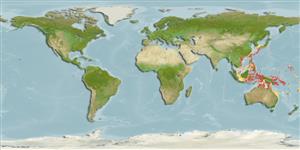Common names from other countries
>
Gobiiformes (Gobies) >
Gobiidae (Gobies) > Gobiinae
Etymology: Eviota: No etymology given, suggested by Christopher Scharpt: from Latin 'eu' for 'true' and 'iota' for anything very small, in combination 'truly very small' referring to it as being the smallest vertebrate at the time it has benn described by Jenkins (thus, making the suggestion by Scharpt plausible.; fallax: Name from Latin word 'fallax' meaning deceitful, false; refers to its superficial similarity to Eviota natalis; noun in apposition..
Environment: milieu / climate zone / depth range / distribution range
Οικολογία
Θαλασσινό(ά) Υφαλόφιλο(α); εύρος βάθους 8 - 31 m (Ref. 79588), usually 8 - 15 m (Ref. 79588). Tropical
Western Pacific: Indonesia (Bali, West Papua, Banda, and Sangihe Island), Papua New Guinea (Kimbe, New Britain), Solomon Islands, Philippines, Micronesia (Chuuk, Yap, and Ngulu Atoll), and Japan (Ryukyu Islands).
Μέγεθος / Βάρος / Age
Maturity: Lm ? range ? - ? cm
Max length : 1.8 cm SL αρσενικό/απροσδιόριστο; (Ref. 79588)
Short description
Κλείδες προσδιορισμού | Μορφολογία | Μορφομετρία
Ραχιαίες άκανθες (συνολικά) : 7; Μαλακές ραχιαίες ακτίνες (συνολικά) : 9; Εδρικές άκανθες: 1; Μαλακές εδρικές ακτίνες: 8. This species is distinguished from its congeners by the following characters: dark occipital spot, more well-developed in males and in preservation; an orange spot behind the eye in life; cephalic sensory-pore system pattern Group I (complete); dorsal/anal formula often 9/8; eye diameter 26.7-34.4% HL; caudal-peduncle depth 10.9-12.4% SL; 4th pelvic-fin ray with short, thick branches bound together by membranes (Ref. 79588).
Inhabits rocky caverns or coral heads on sand seen most frequently at depths of about 8-15 m on either live coral (frequently faviids) or on rocky surfaces covered with coralline algae patches (Ref. 79588).
Life cycle and mating behavior
Maturities | Αναπαραγωγή | Spawnings | Egg(s) | Fecundities | Προνύμφες
Greenfield, D.W. and G.R. Allen, 2012. Eviota fallax, a new dwarfgoby from the Western Pacific (Teleostei: Gobiidae). Zootaxa 3522:42-48. (Ref. 79588)
IUCN Red List Status (Ref. 130435)
CITES (Ref. 128078)
Not Evaluated
Threat to humans
Harmless
Human uses
Εργαλεία
Special reports
Download XML
Διαδικτυακές πηγές
Estimates based on models
Preferred temperature (Ref.
115969): 26.7 - 29.2, mean 28.7 (based on 662 cells).
Phylogenetic diversity index (Ref.
82804): PD
50 = 0.5000 [Uniqueness, from 0.5 = low to 2.0 = high].
Bayesian length-weight: a=0.01023 (0.00477 - 0.02194), b=3.02 (2.84 - 3.20), in cm Total Length, based on LWR estimates for this (Sub)family-body shape (Ref.
93245).
Τροφικό Επίπεδο (Ref.
69278): 3.0 ±0.3 se; based on size and trophs of closest relatives
Fishing Vulnerability (Ref.
59153): Low vulnerability (10 of 100).
